"The art of metalwork is
special for horse-riding
nations like the Parses"
, L. Van den Bergh
Exploring metal, was the
beginning of important
changes in the civilization
of man. Without any doubt,
the first people, who were
successful in making metal
objects, were the pioneers
of their age. In Iran, the
art of metal work goes back
to the pre historic era.
The people who were living
on Iran's plateau first
proceeded to metal work
because of necessity. But
little by little this
industry was combined with
artistic creativity.
In the myths about ancient
Persians, there are splendid
tales about how metal was
explored. Ferdowsi, the
great epic Persian poet, has
told some of these
historically originated
tales in his very famous
poetical work "Shahname".
In "Avesta," the holy book
of ancient Iranians, four
kinds of metals, gold,
silver, steel and a kind of
Iron-alloy are mentioned.
"It is correct the statement
which said Iran had been the
first country in which metal
was used. Because, unlike "Beinolnaherin"
(Mesopotamia), Egypt and the
"Sind Valley" this country
has been rich in mines of
metal. Metals like gold,
silver, copper, iron, lead,
had been quarried in Iran
and mostly in an area called
"Carmania".
Ancient discoveries in
different parts of Iran tell
us that the people of this
land in addition to the
exploration of different
kinds of metals were
skillful in making varieties
of metallic objects and
alloys. They also invented
the first kind of copper
forge in order to form
metal.
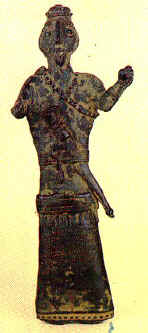
Metallic statute of
human- Lorestan (2000 B.C.)
From the fifth thousand
years (BC) little copper
objects have been found in "Sialk"
of "Kashan", which were
formed by hammering. The
dwellers of this area were
aware of forming
characteristic of copper. In
order to melt the copper,
they needed to have forges
with a temperature of about
1,200 degree centigrade, but
their primary forges failed
to reach such a temperature.
In the fourth to the second
thousand years (B.C.) they
invented bellow and by using
this device air was passed
into the forge forcefully to
raise the temperature up to
1200'.
This temperature was enough
for melting copper. In an
epigraph explored in
"Shush," metal workers are
shown blowing into the
forge.)
In the second part of the
third thousand years (B.C.),
using metal flourished.
Bronze and silver objects
were found in "Shush" and "Tepe-Hissar":
"Tepe Ciyan" belonged to
this era of developing of
art with metal work. At the
end of the third and the
second thousand years (B.C.)
art in bronze work in Iran
was greatly improved and was
carried out skillfully.
Artistic artisans combined
copper with tin and produced
a kind of alloy and by
combining of copper with
zinc produced a bronze
alloy.
Explorations about
civilization belonging to "Sialk,"
"Hasanlue," "MarIik," and "Ziwiye"
showed that metal work was
widespread among the people
of these areas and that the
artisans of this races were
skillful artists.
The art of using metal
started from the "Kassites"
era in "Zagross" region.
Metal industries were
improved during this age.
Without any doubt, the way
of life of the people,
herding and farming, was a
suitable factor of this
progress. This industry
increased so rapidly that at
present, there can be found
many forges and main mines
of explored metals on Iran's
plateau boundary mountain
chains and at the margin of
central desert. During a
long period of change, the
use of stone arms and tools
were abolished as metal arms
like daggers, lances and
copper poniard became
plentiful.
In the ancient area of "Zagross"
and among the graves, many
object made of bronze, gold,
silver and iron, have been
excavated.
Metalic objects from the
Zagross region can be
divided into four
categories. Studying each
part of these objects
show the kinds of needs of
man during that age.
The applications and the
artistic characteristics of
each of them are
considerable.
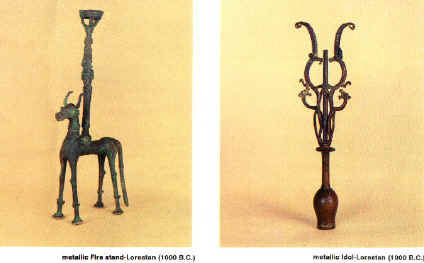
Metallic Fire stand
and Idol- Lorestan (1000
B.C.)
The mentioned categories are
as follows:
1- Defensive arms consisting
daggers, swords, maces,
shields, axes and arrow
heads.
2- Equipment and ornaments
for horses like ordinary and
ceremonial bridles,
different suspenders, hawk
bells and components of
carts.
3- Ornamentals consist of
necklaces, rings, earrings,
hair-clips, buttons, mirrors
and safety pins.
-
Different kinds of
dishes consisting water
bowls (special for
mourning ceremonies),
cups and cylindrical
seals. Exploring the
treasure of "Ziwiye" in
Kurdestan introduces
other artistic races who
lived in the northern
valleys of Zagross.
Valuable treasure is to be
found in the remnants of a
castle amongst the
fortification of "lzirtu"
the capital city of "Mannai."
The art collection of "Ziwiye"
consist of different
valuable ornaments objects
made of gold, silver and
ivory.
Unknown artists of Ziwiye
tried their best skills to
make ornamental objects from
valuable metals, in the
seventh and eight centuries
before the Christ.
Stereotypes of Ziwiye's
treasure are kept in "Iran
Bastan" Museum. Discovering
metal dishes of Marlik in
1961 in a region called "Roodbar"
in "Gillan" has proved to be
one of the greatest
treasures of metalwork in
Iran.
The artistic and production
quality of these works
symbolize the existence of a
high-class school of art and
industry in ancient Iran
about three thousands years
ago (the end of the second
and the beginning of the
first thousand years BC).
Metal treasures of "Marlik"
were obtained from 53 graves
belonging to rulers,
commanders and their
families and consist of 63
pieces of dishes and objects
made of gold, silver and
bronze which have been
created with extreme
dexterity.
The collections include
cups, bowls, tumblers,
plates, containers with long
necks, pots and other
ornamental objects. A lot of
dishes of metal found in
Marlik are made by gold and
kinds of alloys. The number
of silver dishes are less
and the number of objects
made of bronze are more than
the objects made of gold.
|
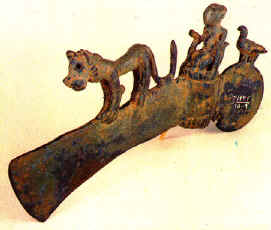 |
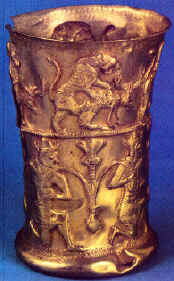 |
|
Metallic Axe-
Lorestan (1000 B.C.) |
Golden cup- Gilan
(2000-1000 B.C.) |
Silver and golden containers
are created in different
shapes with different
ornaments in different
sizes. There are much
decorations on cups to
create the scarcest
masterpieces. One of the
famous golden cups is
nominated by the name of its
discovery site as the
"Golden Cup of Marlik"
because of its extremely
skilled creation and its
marvelous quality.
The gold, which is used in
the "Marlik cup," has been
selected for its purity and
because its flexibility
allowed the creation of such
scarce and complex
decorations. The decorations
on the body show four winged
cows, which has been
embossed by very skillful
hammer working. And it is
really embossed.
The cup of "The Tale of
Life," a golden cup with a
horned horse and other ones,
which show a "Simorg" and a
winged cow are among the
other valuable works of
artists from "Marlik"
civilization. In addition to
the simple designs and
drawing on the metal
containers of Marlik, there
could be seen ornamental
visualizing designs, which
symbolized the unique
imaginations of the artists
of Marlik.
In the metal works of Marlik
there can be seen
smoothness, beauty, action
and life in their designs.
All the things are shown in
action, nothing can be found
still in these designs.
Deers, horned horses, winged
cows, hunters, eagles and
birds created on the bodies
of cups present kinds of
motion. Even a goat engraved
on the body of one of the
cups is represented by a
kind mother goat fondling
her child goat. The school
of art of Marlik was a new
motion and a unique one
belonging to this
magnificent civilized
culture. The influence of
this race's industry and art
of metal work can be seen in
a vast area in the ancient
world and also thereafter in
other civilizations
especially in the Mad and
Hakhamaneshian In
Hakhamaneshian era (550-530
B.C.), metalwork enjoyed a
great importance among
Persian artists.
Hakhamaneshian artists
produce a variety in arms
and ornamental objects made
from metals. The artistic
standards of this age
continued in the "Partian"
era and were elevated in the
Sassanian era.
|
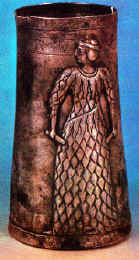 |
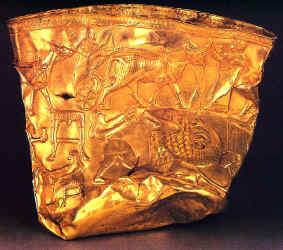 |
|
Silver cup-
Marvdasht (End 0f
3000 B.C.) |
Golden cup-
Hasanlou (1000 B.C.) |
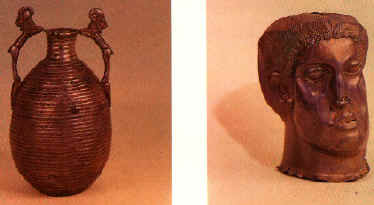 |
|
Silver jar-
Achaemenian
|
Silver hollow head
(300-200 B.C.)
|
Sassanian artists presented
an extreme skillfulness in
metal works. Cups and
containers of silver created
by artists of this era hold
simple ornamental embossed
designs, which is unique
regarding the opinion of
scholars of art. They showed
much skills in jewels inlaid
on metal containers. One of
them beautiful metal works
of the Sassanian era is a
golden jewel inlaid cup
called the "Solomon cup".
This cup is kept in Medal's
Hal in Paris (Cabine des
Me'dailles). Its surface
from inside and outside is
skillfully decorated with
ruby. Silver utensils
belonging to the Sassanian
era are the best types of
art in metal work. Decorated
designs on the bodies of
these utensils show hunting,
animals and birds.
A silver and golden utensil
is in the "Metropolitan
Museum," which carries a
design showing Firooz, the
First Sassanian king
(457-463 AD.) going to hunt
a wild goat using bows and
arrows.
The most important metal
works of Sassanian era was
kept in the "Hermitage
Museum." Some other
unique samples are different
collections in Europe and
America.
In studying the art of metal
work in Iran, the emergence
of golden coins in the
Hakhamaneshian era must be
regarded. Under Daryoosh the
First, the king from the
Hakhamaneshian's era
(522-489 BC) golden
coins were coined for the
first time in the work. The
name of these coins were "Derik".
Copper and bronze and silver
coins were made widespread,
but after the initiation of
the Iranians, gold coinage
became widespread in other
parts of the world.
Golden coin was one of the
most important invention of
man in facilitating
commercial exchange. There
was a picture of Daryoosh
the first engraved on the
first golden coins of the
world. This design shows him
kneeling down and pulling
the string of a bow, he wore
a Persian cloth. On the tail
of this coin there are
unknown signs. After
Hakhamaneshian, coining have
been continued in Sassanian
era and then after in each
ages, valuable works were
created, many samples of
coins belonging to different
historical era in Iran have
been explored in
archaeological excavations
and are kept in considerable
museums of the world and
also in private collections.
The art of metal work in
Iran, after emerging of
Islam, started, with art of
Sassanian in its back
ground. Iranian artists
could reveal their talent
after reposing.
Continuation of Sassanian
style in metal work of early
Islam era especially in
silver utensils is obvious
Two silver utensils
belonging to the post
Sassanian era kept in
Ermitage museum. There are
designs about famous tale of
"Bahram goor" and "Azadeh"
on them. Silver utensils
having designs of animals
and birds engraved on them,
are an important group of
metal works of early Islamic
period. There were more
quill driving and engraving
works rather then embossing
works in this age.
One of the characteristics
of metal work in Islamic era
is the variety of creating
shape and form in utensils.
Among metal objects most
remaining after the
emergence of Islam in Iran
are as follows:
Different decanters, trays,
containers, Cases for Quran,
candelabrums, bronze cups,
ewers, censers, designed
bronze and copper utensils.
In addition to these, silver
utensils and beautiful
ornamental objects have
remained from this era,
which are valuable from the
artistic point of view.
The impact of Persian art on
Arabs and other nations
after Islam, symbolize the
value of Iranian art and
culture.
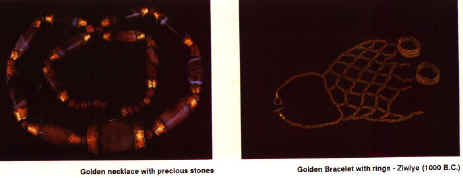 |
|
Golden
necklace with
precious stones
|
Golden Bracelet
with rings- Ziwiye
(1000 B.C.) |
|
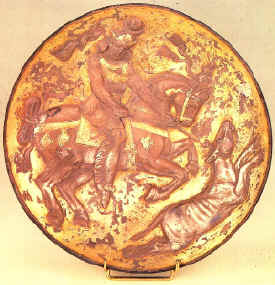 |
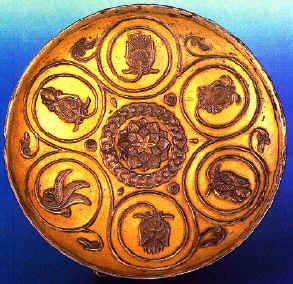 |
|
Silver plate
with golden pieces
(300-700 A.D.) |
Silver dish
with golden pieces-
Hamedan (600-700
A.D.) |
The Arabs, lacking arts
industries, little by little
have become familiar with
the metal works of Iranians.
The scope of such effects
ere so great that after some
centuries, they were seen in
India in the Ottoman Turk
empire and even European
nations. One of the glorious
ages of metal works in Iran
after Islam is Saljooghian
era. Muslim Persian metal
workers of this age created
works which are unique.
After overcoming of
Saljooghe (from Saljooghian
dynasty) in the eastern part
of Iran (1037 A.D.) a
glorious age of metal
working started. Saljooghe's
innovative artists created
new designs and decorations
on bronze gold and silver
dishes. Most Saljooghian's
dishes were made in the
eleventh and thirteenth
centuries. These Works now
have great fame among art
evaluators and scholars. Two
bronzes, silver trays and
bronze cups, decanters,
flasks, and candelabrums and
ewers, from the Saljooghians
era are among the most
famous artistic masterpieces
from Islamic art of this
age.
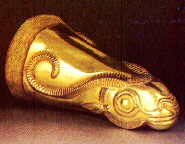 |
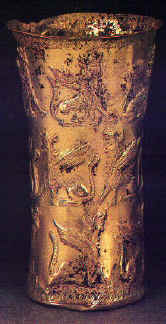 |
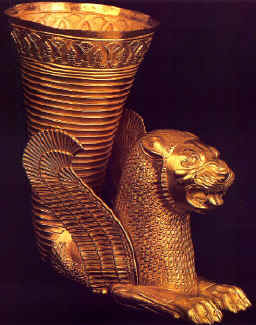 |
|
Golden rhyton |
Silver bowl-
Mazandaran |
Golden rhyton-
Hamedan, Achaemanian
(500 B.C.) |
Epigraphs have been found in
Farsi and Arabic among
remnants belonging to
Saljooghian age which show
the artists of this age used
script in the best way as a
factor of decoration. Metal
workers of Saljooghian era
mainly used two different
styles, complementary to
each other. One way was to
cover the complete surface
of the metal objects with a
number of designs and
layouts that add glory to
the manifestation of their
works. The other way was to
choose a very simple base
(background) in order to
make the main designs more
outstanding. These simple
designed bronze works 'were
very accomplished that
reflect similar works
belonging to the
renaissance. From the 15th
century (A.D.) we can see
the influence of Iran's
metal works in Europe. At
the beginning of the
century, some Venetian
merchants in Egypt, became
familiar with the art of
metal workers from Iran and
Egypt, invited some of them
to Venice. The works of
these artists were welcomed
by European and the style of
these artists developed in
Venice and other parts of
Europe.
The interesting point is
that the Saljooghe's artists
sealed a special sign on all
of their metal works. This
sign symbolized a falcon
sitting over its bait, which
was a little bird, with its
beak thrust into the bird's
body.
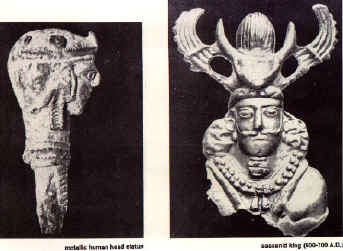
Metalic human head
statue Sasanid King
(600-700 A.D.)
Earlier the invasion of the
Mongols at the beginning of
12th century (A.D.) caused a
bitter impact on art and
artists of Iran. After a
silent age there came to
start glorious art in metal
work in the west of Iran.
Little by little it expanded
to Fars and Khorassan in the
middle of 14th century. From
remnants, belonging to the
second half of the
fourteenth century, we can
better see characteristics
of metal working during the
domination of the Mogols in
Iran. Several metal boxes,
candelabrums and other works
of this age are kept in
museums such in
Metropolitan, in Baltimore
and in Cairo.
|
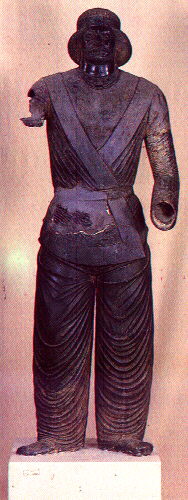 |
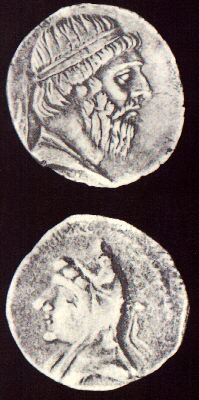 |
|
Metalic
parthian statue
(100 A.D.) |
|
In Teimoorian era
(1370-1502A.D.) metal
workers made objects simple
and without any decorations.
In this age, improvement was
slow to gain the importance
of Saljooghe's.
In "Harat" the center of "Khorassan"
there were made different
metal utensils made of
copper, bronze, iron and
steel. These dishes were
made extremely skillfully,
especially in gold and
silver. The art of metal
work of the Taimoorian era
is largely indebted to their
ancestors' experiences.
Improvement in metal work
took place gradually. The
Persians did not react
strongly against the
invaders, but with the
passing of time, they were
successful in introducing
their culture and art to the
invaders and making them
interested in their Metal
work in Safavian era
(1502-1736 A.D.) came into a
new stage of style, variety,
beauty and preciousness.
Among the qualities of
precious art of the
Safavians was its elegance
of designs and Farsi scripts
in the form of verses or
historical contents, and the
names of Twelve (Shi'a)
Imams written on them.
|
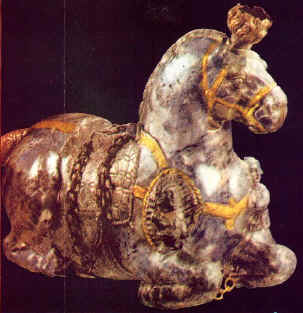 |
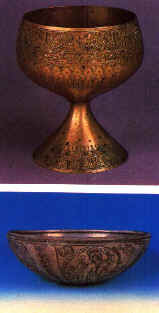 |
|
Horse
statue- Deilaman
(300 A.D.) |
|
The art of metal work during
the age of Safavian, was
established on old customs
and the skill of the artists
of this era, represented by
the dexterity and genius in
metal works. Designers and
painters in this age
underwent considerable
change with beauty and
elegance replacing much
roughness which had been
seen sometimes in ancient
works.
In particular in this age,
delicate and beautiful
candelabrums were made in
different splendid forms.
There were changes in
engraved censers and
candelabrums with Persian
scripts substituted for
Arabic one. The form of the
handwriting was also changed
to "Naskh" and "Soiths" (two
kinds of writing styles used
in calligraphy). These
scripts were written by the
greatest calligraphists of
that age.
The symbol of Safavis metal
workers is a lion attacking
a reindeer, sitting on its
neck and tearing it apart.
Works like ewers, torches,
cups, and caps for
containers are full of
innovations and artistic
masterpieces. Jewelry inlaid
dishes belonging to the
Safavi's era, are famous for
their beautiful and elegance
jewels inlaid in bronze
objects, which had declined
in 15th century, flourished
again in this era. Usually
they used to whiten copper
to make it similar to
silver. The decorations of
this era show changing
tastes of artists. One of
the outstanding samples of
metallic works belonging to
the 16th century is a copper
bowl, marvelously engraved
with the designs of many
kinds of herbs, which is now
kept in the Metropolitan
museum.
Safavi metal workers were
also most skillful in
managing iron and steel.
They extensively improved
the art of steel
articulation. Steel workers
were used in the decoration
of clothes, making weapons
or fire arms, epigraphs,
chain, helmets and shield.
Making steel doors and
windows for sacred places
and graves for religious
leaders also flourished in
this age.
Astrolabes were one of the
other metal objects which
Safavi's artists showed
their talent by making it.
Safavi's kings believed in
astrolabes and astronomical
commandments.
|
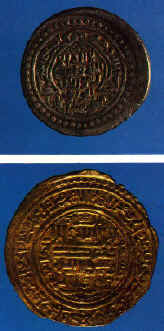 |
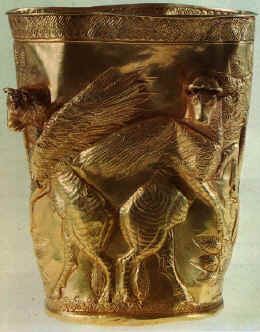 |
|
Silver tray-
Historical period |
Marlic
golden cup
(2000-1000 B.C.) |
The astrolabe is a tool made
of bronze, which has been
used by astronomers to
measure the distances
between stars, from the noon
and sun and also it was used
for anticipating lunar
eclipses and also eclipses
of the sun.
The oldest Persian astrolabe
is kept in Oxford museum in
England and belonged to the
fourth century' A.H. (Anno
Hejira). Sixty-seven
historical astrolabes from
Iran, which symbolize
another part of the art and
industries of Persian metal
work artists, are kept in
great museums of the world
and in personal collections.
The art of metal works in
the Safavi era had such
value that metal workers at
present also are effected by
them. Most works of present
artists have been under the
influence of the Safavi's
style, while the
Taimoorian's style also has
its advocates.
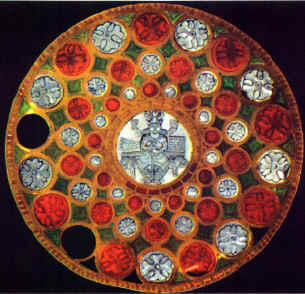
Khosrow the first
cup (600 A.D.) |




